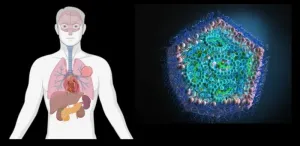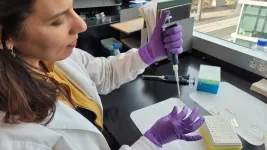(Press-News.org) A vascular ‘fingerprint’ on the light sensitive tissue layer at the back of the eye—the retina—can predict a person’s risk of stroke as accurately as traditional risk factors alone, but without the need for multiple invasive lab tests, finds research published online in the journal Heart.
The fingerprint, comprising 29 indicators of vascular health, is a practical and readily implementable approach that is particularly well suited for primary healthcare and low-resource settings, conclude the researchers.
Stroke affects around 100 million people around the globe and kills 6.7 million of them every year, point out the researchers. Most cases are caused by modifiable risk factors, such as high blood pressure, high cholesterol, poor diet, and smoking.
The retina’s intricate vascular network is known to share common anatomical and physiological features with the vasculature of the brain, making it an ideal candidate for assessing damage from systemic ill health, such as diabetes, explain the researchers.
Its potential for stroke risk prediction hasn’t been fully explored, due to variable study findings and inconsistent use of the specialised imaging technique for the back of the eye— fundus photography—they add.
But machine learning (AI), such as the Retina-based Microvascular Health Assessment System (RMHAS), has opened up the possibilities for the identification of biological markers that can accurately predict stroke risk without the need for invasive lab tests, say the researchers.
To explore this further, they measured 30 indicators across 5 categories of retinal vascular architecture in fundus images from 68,753 UK Biobank study participants.
The 5 categories included calibre (length, diameter, ratio) density, twistedness, branching angle and complexity of the veins and arteries.
And they accounted for potentially influential risk factors: background demographic and socioeconomic factors; lifestyle; and health parameters, including blood pressure, cholesterol, HbA1c (blood glucose indicator), and weight (BMI).
The final analysis included 45,161 participants (average age 55). During an average monitoring period of 12.5 years, 749 participants had a stroke.
These people tended to be significantly older, male, current smokers, and to have diabetes. They also weighed more, had higher blood pressure, and lower levels of ‘good’ cholesterol, all of which are known risk factors for stroke.
In all, 118 retinal vascular measurable indicators were included, of which 29 were significantly associated with first time stroke risk after adjusting for traditional risk factors. Over half (17) were density indicators; 8 fell into the complexity category; 3 were calibre indicators; and 1 came under the twistedness category.
Each change in density indicators was associated with an increased stroke risk of 10-19%, while similar changes in calibre indicators was associated with an increased risk of 10-14%.
Each decrease in the complexity and twistedness indicators was associated with an increased risk of 10.5-19.5%.
This retinal ‘vascular fingerprint’, even when combined with just age and sex, was as good as the use of traditional risk factors alone for predicting future stroke risk, the findings showed.
This is an observational study, and therefore no firm conclusions can be drawn about cause and effect. And the researchers acknowledge that the findings may not apply to diverse ethnicities as most of the UK Biobank’s participants are White. Nor were they able to assess the risk associated with different types of stroke.
Nevertheless, they conclude: “Given that age and sex are readily available, and retinal parameters can be obtained through routine fundus photography, this model presents a practical and easily implementable approach for incident stroke risk assessment, particularly for primary healthcare and low-resource settings.”
END
Vascular ‘fingerprint’ at the back of the eye can accurately predict stroke risk
Combined with age and sex, predictive power as good as that of traditional risk factors alone. Practical, easily implementable approach for primary healthcare and low-resource settings
2025-01-14
ELSE PRESS RELEASES FROM THIS DATE:
Circulation problems in the brain’s seat of memory linked to mild cognitive impairment in older adults
2025-01-14
Mild cognitive impairment is linked to blood vessel dysfunction in the brain’s temporal lobes — the seat of memory — according to a new USC-led study.
The findings, seen in people with and without signs of amyloid buildup in the brain, suggest that microvascular trouble may be an important, early biomarker for dementia as well as a potential target for therapy.
The research, involving scientists from multiple universities, appears in the journal Neurology.
“We’re studying ...
Oregon State receives $11.9 million from Defense Department to enhance health of armed forces
2025-01-13
PORTLAND, Ore. – The U.S. Department of Defense has awarded up to $11.9 million to Oregon State University to invent new drug delivery technologies for protecting members of the military from a range of health threats in combat areas.
Once designed, developed and tested, the technologies could also be applied as needed within the general public, said OSU College of Pharmacy nanomedicine researcher Gaurav Sahay, the project leader.
The award comes from the Defense Advanced Research Projects Agency through its Hermes program, whose goal is finding new ways to deliver therapeutic agents throughout the body with exceptional ...
Leading cancer clinician, researcher Dr. Jenny Chang to lead Houston Methodist Academic Institute
2025-01-13
Esteemed cancer clinician-scientist Jenny Chang, M.D., MBBChir, MHCM, has been chosen to lead the Houston Methodist Academic Institute. She will serve as executive vice president, president and CEO, and chief academic officer.
In her more than 15 years at Houston Methodist, Chang helped transform the Dr. Mary and Ron Neal Cancer Center into one of the top-20 ranked cancer centers in the country.
Chang, the Emily Herrmann Presidential Distinguished Chair in Cancer Research, was selected following a national search and succeeds H. Dirk Sostman, M.D., FACR, who will retire next month after two decades of leadership at Houston Methodist.
Chang’s ...
Engineering quantum entanglement at the nanoscale
2025-01-13
Physicists have spent more than a century measuring and making sense of the strange ways that photons, electrons, and other subatomic particles interact at extremely small scales. Engineers have spent decades figuring out how to take advantage of these phenomena to create new technologies.
In one such phenomenon, called quantum entanglement, pairs of photons become interconnected in such a way that the state of one photon instantly changes to match the state of its paired photon, no matter how far apart they are.
Nearly 80 years ago, Albert Einstein referred to this phenomenon as "spooky action at a distance." Today, entanglement is the subject of research ...
Researchers develop breakthrough one-step flame retardant for cotton textiles
2025-01-13
Although extremely flammable, cotton is one of the most commonly used textiles due to its comfort and breathable nature. However, in a single step, researchers from Texas A&M University can reduce the flammability of cotton using a polyelectrolyte complex coating. The coating can be tailored for various textiles, such as clothing or upholstery, and scaled using the common pad-dry coating process, which is suitable for industrial applications. This technology can help to save property and lives on a large scale.
“Many of the materials in our ...
New study identifies how blood vessel dysfunction can worsen chronic disease
2025-01-13
Researchers at Oregon Health & Science University have uncovered how specialized cells surrounding small blood vessels, known as perivascular cells, contribute to blood vessel dysfunction in chronic diseases such as cancer, diabetes and fibrosis. The findings, published today in Science Advances, could change how these diseases are treated.
The study, led by Luiz Bertassoni, D.D.S., Ph.D., founding director of the Knight Cancer Precision Biofabrication Hub and a professor at the OHSU Knight Cancer Institute and ...
Picking the right doctor? AI could help
2025-01-13
Years ago, as she sat in waiting rooms, Maytal Saar-Tsechansky began to wonder how people chose a good doctor when they had no way of knowing a doctor’s track record on accurate diagnoses. Talking to other patients, she found they sometimes based choices on a physician’s personality or even the quality of their office furniture.
“I realized all these signals people are using are just not the right ones,” says Saar-Tsechansky, professor of information, risk, and operations management at Texas McCombs. “We were operating in complete darkness, like there’s no transparency on these things.”
In new research, she uses artificial ...
Travel distance to nearest lung cancer facility differs by racial and ethnic makeup of communities
2025-01-13
Embargoed for release until 5:00 p.m. ET on Monday 13 January 2025
@Annalsofim
Below please find summaries of new articles that will be published in the next issue of Annals of Internal Medicine. The summaries are not intended to substitute for the full articles as a source of information. This information is under strict embargo and by taking it into possession, media representatives are committing to the terms of the embargo not only on their own behalf, but also on behalf ...
UTA’s student success strategy earns national acclaim
2025-01-13
The University of Texas at Arlington has been recognized nationally for its commitment to student success and economic mobility, being named a winner in the inaugural Postsecondary Success Recognition Program (PSRP), a U.S. Department of Education initiative. This program honors institutions that excel in enrolling underserved student populations, supporting successful student transfers and completions and preparing graduates for careers that promote economic mobility.
UTA was one of only three bachelor’s degree–granting institutions across the nation ...
Wind turbines impair the access of bats to water bodies in agricultural landscapes
2025-01-13
Bats depend on open bodies of water such as small ponds and lakes for foraging and drinking. Access to water is particularly important for survival in the increasingly hot and dry summers caused by climate change, the time when female bats are pregnant and rear their young. A scientific team from the Leibniz Institute for Zoo and Wildlife Research (Leibniz-IZW) has now shown that access to drinking sites is hampered by wind turbines in agricultural landscapes: Many bat species avoid the turbines and water bodies ...
LAST 30 PRESS RELEASES:
Making lighter work of calculating fluid and heat flow
Normalizing blood sugar can halve heart attack risk
Lowering blood sugar cuts heart attack risk in people with prediabetes
Study links genetic variants to risk of blinding eye disease in premature infants
Non-opioid ‘pain sponge’ therapy halts cartilage degeneration and relieves chronic pain
AI can pick up cultural values by mimicking how kids learn
China’s ecological redlines offer fast track to 30 x 30 global conservation goal
Invisible indoor threats: emerging household contaminants and their growing risks to human health
Adding antibody treatment to chemo boosts outcomes for children with rare cancer
Germline pathogenic variants among women without a history of breast cancer
Tanning beds triple melanoma risk, potentially causing broad DNA damage
Unique bond identified as key to viral infection speed
Indoor tanning makes youthful skin much older on a genetic level
Mouse model sheds new light on the causes and potential solutions to human GI problems linked to muscular dystrophy
The Journal of Nuclear Medicine ahead-of-print tip sheet: December 12, 2025
Smarter tools for peering into the microscopic world
Applications open for funding to conduct research in the Kinsey Institute archives
Global measure underestimates the severity of food insecurity
Child survivors of critical illness are missing out on timely follow up care
Risk-based vs annual breast cancer screening / the WISDOM randomized clinical trial
University of Toronto launches Electric Vehicle Innovation Ontario to accelerate advanced EV technologies and build Canada’s innovation advantage
Early relapse predicts poor outcomes in aggressive blood cancer
American College of Lifestyle Medicine applauds two CMS models aligned with lifestyle medicine practice and reimbursement
Clinical trial finds cannabis use not a barrier to quitting nicotine vaping
Supplemental nutrition assistance program policies and food insecurity
Switching immune cells to “night mode” could limit damage after a heart attack, study suggests
URI-based Global RIghts Project report spotlights continued troubling trends in worldwide inhumane treatment
Neutrophils are less aggressive at night, explaining why nighttime heart attacks cause less damage than daytime events
Menopausal hormone therapy may not pose breast cancer risk for women with BRCA mutations
Mobile health tool may improve quality of life for adolescent and young adult breast cancer survivors
[Press-News.org] Vascular ‘fingerprint’ at the back of the eye can accurately predict stroke riskCombined with age and sex, predictive power as good as that of traditional risk factors alone. Practical, easily implementable approach for primary healthcare and low-resource settings





